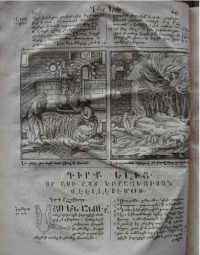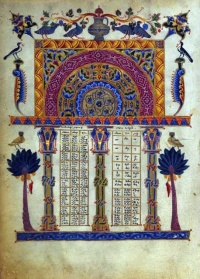Bible translations into Armenian
From Textus Receptus
| Line 1: | Line 1: | ||
[[Image:Page from Armenian bible illuminated by T'oros Roslin, 1256.jpg|thumb|200px|right|Illustrated Armenian Bible from 1256]] | [[Image:Page from Armenian bible illuminated by T'oros Roslin, 1256.jpg|thumb|200px|right|Illustrated Armenian Bible from 1256]] | ||
| - | The Armenian Bible is due to [[Saint Mesrob]]'s early-5th-century translation. The first monument of Armenian literature is the version of the Holy Scriptures. Isaac, says Moses of Chorene, made a translation of the Bible from the Syriac text about 411. This work must have been considered imperfect, for soon afterwards John of Egheghiatz and Joseph of Baghin were sent to Edessa to translate the Scriptures. They journeyed as far as Constantinople, and brought back with them authentic copies of the Greek text. With the help of other copies obtained from Alexandria the Bible was translated again from the Greek according to the text of the [[Septuagint]] and [[Origen]]'s ''[[Hexapla]]''. This version, now in use in the Armenian Church, was completed around the year 434. | + | [[Image:Armbible.jpg|thumb|200px|right||Excerpt from the first printed Armenian Bible, Amsterdam, [[1666 AD|1666]].]] |
| + | The Armenian Bible is due to [[Saint Mesrob]]'s early-5th-century translation. The first monument of Armenian literature is the version of the Holy Scriptures. Isaac, says Moses of Chorene, made a translation of the Bible from the Syriac text about [[411 AD|411]]. This work must have been considered imperfect, for soon afterwards John of Egheghiatz and Joseph of Baghin were sent to Edessa to translate the Scriptures. They journeyed as far as Constantinople, and brought back with them authentic copies of the Greek text. With the help of other copies obtained from Alexandria the Bible was translated again from the Greek according to the text of the [[Septuagint]] and [[Origen]]'s ''[[Hexapla]]''. This version, now in use in the Armenian Church, was completed around the year 434. | ||
The first sentence in Armenian written down by St. Mesrop after he invented the letters is said to be the opening line of Solomon's [[Book of Proverbs]]: | The first sentence in Armenian written down by St. Mesrop after he invented the letters is said to be the opening line of Solomon's [[Book of Proverbs]]: | ||
| - | : | + | :Ճանաչել զիմաստութիւն եւ զխրատ, իմանալ զբանս հանճարոյ: |
| - | ''Čanačʿel zimastutʿiwn ew zxrat, imanal zbans hančaroy.'' | + | :''Čanačʿel zimastutʿiwn ew zxrat, imanal zbans hančaroy.'' |
| - | "To know wisdom and instruction; to perceive the words of understanding."[[ | + | :"To know wisdom and instruction; to perceive the words of understanding."[[Proverbs 1:2]]. |
| - | + | ||
| + | ==Oskan Bible== | ||
The first complete Bible into Armenian was the Oskan Bible of 1666, named after printer Oskan Erewants‘i ("Oskan of Yerevan", 1614‒74). Oskan translated and edited the text from a single manuscript which had been copied in 1295 for King Het’um II of the Cilician Kingdom of Armenia<sup>[1]</sup> The bible is 1,462 double pages in length with also 159 illustrations by the Dutch artist Christoffel van Sichem (1581‒1658). It includes the prefaces and introductions to the books by Jerome. At the end of the work is an extensive and detailed colophon addressed to the readers in which he explains that he edited the Bible to bring the verses, chapters, and numberings in accord with the Western translations. | The first complete Bible into Armenian was the Oskan Bible of 1666, named after printer Oskan Erewants‘i ("Oskan of Yerevan", 1614‒74). Oskan translated and edited the text from a single manuscript which had been copied in 1295 for King Het’um II of the Cilician Kingdom of Armenia<sup>[1]</sup> The bible is 1,462 double pages in length with also 159 illustrations by the Dutch artist Christoffel van Sichem (1581‒1658). It includes the prefaces and introductions to the books by Jerome. At the end of the work is an extensive and detailed colophon addressed to the readers in which he explains that he edited the Bible to bring the verses, chapters, and numberings in accord with the Western translations. | ||
Revision as of 04:02, 8 June 2020

The Armenian Bible is due to Saint Mesrob's early-5th-century translation. The first monument of Armenian literature is the version of the Holy Scriptures. Isaac, says Moses of Chorene, made a translation of the Bible from the Syriac text about 411. This work must have been considered imperfect, for soon afterwards John of Egheghiatz and Joseph of Baghin were sent to Edessa to translate the Scriptures. They journeyed as far as Constantinople, and brought back with them authentic copies of the Greek text. With the help of other copies obtained from Alexandria the Bible was translated again from the Greek according to the text of the Septuagint and Origen's Hexapla. This version, now in use in the Armenian Church, was completed around the year 434.
The first sentence in Armenian written down by St. Mesrop after he invented the letters is said to be the opening line of Solomon's Book of Proverbs:
- Ճանաչել զիմաստութիւն եւ զխրատ, իմանալ զբանս հանճարոյ:
- Čanačʿel zimastutʿiwn ew zxrat, imanal zbans hančaroy.
- "To know wisdom and instruction; to perceive the words of understanding."Proverbs 1:2.
Contents |
Oskan Bible
The first complete Bible into Armenian was the Oskan Bible of 1666, named after printer Oskan Erewants‘i ("Oskan of Yerevan", 1614‒74). Oskan translated and edited the text from a single manuscript which had been copied in 1295 for King Het’um II of the Cilician Kingdom of Armenia[1] The bible is 1,462 double pages in length with also 159 illustrations by the Dutch artist Christoffel van Sichem (1581‒1658). It includes the prefaces and introductions to the books by Jerome. At the end of the work is an extensive and detailed colophon addressed to the readers in which he explains that he edited the Bible to bring the verses, chapters, and numberings in accord with the Western translations.
See also
References
- 1. This manuscript is in the Institute of Ancient Manuscripts, or Matenadaran, in Yerevan.
External links
- interwiki hy:Աստվածաշունչ - Armenian Wikipedia article Bible
- Online Eastern Armenian Bible
- Eastern Armenian Bible for iPhone / iPad / iPod Touch (iTunes link)
- http://armenianbible.org/

